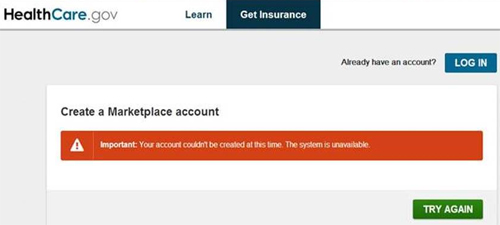Lucky or Smart – Will Healthcare.gov Turn Out To Be Either?
In politics there’s little doubt that it’s better to be lucky than smart.
T hough President Obama is talented and amazingly disciplined, he has unquestionably been breathtakingly lucky – yes, lucky in his timing, and certainly in his opponents.
hough President Obama is talented and amazingly disciplined, he has unquestionably been breathtakingly lucky – yes, lucky in his timing, and certainly in his opponents.
In 2004 Jerry Ryan, Obama’s Republican opponent in the race for the U.S. Senate, withdrew after some very sordid divorce records were made public. It took the Illinois GOP six weeks to find a replacement candidate. That candidate, Alan Keyes, had never lived in Illinois. Obama won in a landslide.
In 2008 he benefited from not belonging to the party of the least popular U.S. president in at least 50 years, a gigantic economic disaster and Sen. John McCain’s … um … unusual choice of Sarah Palin as his running mate. And the Republicans tried to turn the president’s final election into a referendum on Omabacare. A tactic that might have worked had they not picked my former Governor, Mitt Romney — the one member of the GOP who had no standing to criticize the Affordable Care Act because it was virtually the same plan he had proposed and enacted here in Massachusetts.
This month Lady Luck smiled again at Mr. Obama when Texas Sen. Ted Cruz and the House GOP tried to use the government shutdown and debt ceiling fights as a way to defund or delay Obamacare – thus providing the best possible distraction from the Affordable Care Act’s disastrous market entry.

The road to project failure
Let’s face it, when corporate IT projects fail they usually don’t end up in the news – but when politics and public spending are involved they often do. Managing politically charged government IT initiatives is rife with risk. In recent days we’ve seen coverage of no fewer than four states with troubled e-government projects by Deloitte, and a Xerox software outage that halted electronic access to food stamps and other aid for shoppers in 17 states. And over the last two weeks the launch difficulties of Healthcare.gov have become a national fixation.
I’ve run three high profile e-government initiatives efforts in two states, so I have some first-hand perspective of what it is to be on a admittedly smaller hot seat than Health and Human Services Secretary Kathleen Sebelius is on today. While failure rates of IT initiatives are a concern in industry, there are factors that makes government efforts considerably more complicated. Often the details of services, their launch date, budget, and how they’re operated are set in legislation. And too often government officials don’t have operational details of a project finalized until well in to implementation, to allow for deal making. This leads to “high stakes” situations where firms would normally hedge their risks on by reducing scale, adding testing or not kicking off until an initiative is well define.
As a consultant who has taken on troubled projects there’s an art to telling the difference between a salvageable project and one that needs to be shut down faster than a nuclear reactor about to go bad. At the moment there’s a chorus of pundits providing opinions – some more expert than others — of what went wrong.
- Paul Ford says a lack of open source
- A usability firm says design and usability,
- Political supporters say its own success,
- The Daily Beast dislikes its top down authoritarian process.
- The Wall St. Journal suggests ossified Federal procurement laws
- O’Reily hits a few of these, especially load testing.
Everything is easy from a distance
Specialists tend to see problems expressed in whatever lens they use to see the world. And the farther away one stands from any endeavor, the easier it appears. Want to respect NBA players? Watch them work from the front row.
The key question is not what went wrong, but what is it practical to get back on-plan. And based on that, what if any efforts should create alternative solutions through the web or other channels?
Here are the risk buckets I’d consider to figure that out.
First, there’s the inherent risk of technical invention. I’ve managed initiatives that were plagued by underlying issues from providers, and that worked well in the lab but were glitchy in the field. To determine if recovery is practical the managers need to look at how structural the flaw/flaws is/are and how short the runway is to get it right.
Second, there’s the risk of market adoption. Something can be a great deal, but if the sales process is difficult, or the marketing doesn’t feel credible, and especially if it’s an elective service that can be ignored for a little while – then even good offerings will die on the vine. There are non-technical solutions for this sort of problem: One of my innovative yet-still-hard-to-use programs had a “lead pipe guarantee” from that state’s governor. He gave us this by telling our market of 800 or so school districts their state funding would be 100% dependent on their use of the system. This was one of those rare cases where managing motivation and culture was more important that design.
Procurement amidst government dysfunction
Finally, there’s procurement risk which comes from the systematic selection of the wrong vendors. At first there was concern that CGI Group, the Canadian firm which built Healthcare.gov, was one of those wrong vendors because of some earlier legal issues. The jury is still out on that – as reports of the site never being beta tested and huge last minute changes required by the government suggest there is a lot of blame to go around.
And this could include former President’s Bush and Clinton, who cut defense and domestic procurement oversight, even as increasing amounts of government work to shifted to contractors.
Despite concerns of a growing federal government, today there are 800,000 fewer government employees then when Ronald Regan left office. A bit more than half of these are military contractors, remember in 2010 more than half of America military efforts in Iraq and Afghanistan were contractors leading to congressional investigation. With 355,000 fewer civilian workers, the influence of contractors and lobbyists are now an integral part of political and government functioning.
When it comes to governance, quality is more important than quantity
Two decades of reinventing government has resulted in less oversight. And shifts in campaign financing and district maps have resulted in less accountability for legislators who are now less beholden to party and local interests as reflected by low levels of public approval. At this moment Congress may be the only group less popular than the contractors behind the HealthCare.gov website.
Optimism: some runway exists
There are three things (all technical risks) that would doom this project: Internal data corruption, inaccurate price quoting, or a security breach. So far, these have not happened at scale. Reportedly, 10 million users hit the site on its first day – exposing latency, user interface, and capacity issues. These can be addressed with an amount of brute force. Further, people have until December 15th to register – and they don’t have to register through a website. Phone centers, in-person services at hospitals, or mobile registration (as is done for voter registration) could all be contemplated.
Concern: technical and political structures
For every dollar spent on the front stage of an enterprise web system, two to three must be spent backstage to make it work. If the integration between healthcare.gov and insurers isn’t working, or if the data which the site must pull in isn’t ready for use, that will be difficult to remedy quickly.
There is a lack of transparency that leaves outsiders to assume, or assert the worst. Public relations of this failure have been handled badly, and the arrival of Jeffrey Zients as the high-profile manager of this project rescue is a positive step, time is short.
Meanwhile, political factors are kicking in. It would seem there is the equivalent of a “suppress the vote” campaign going on with Obamacare. Some conservative groups are buying media to warn young prospects away from enrolling. If younger consumers who are still on the fence about buying coverage sit this round out and pay a one-time penalty, while only motivated sick people bother to register, then insurers may end up with too few healthy members to offset the costs of less-healthy enrollees.
But at this point the question really is no longer about people getting healthcare, or the quaint idea of fixing a website. Talk of fixing this mechanism of policy may quickly shift in to another attempt at repealing the Affordable Care Act. There will be a time of accountability for this snake-bit web launch but that should be after the fact so it doesn’t disrupt whatever repair work is possible to get Healthcare.gov up and running.
That kind of interruption is how political theater overtakes policy — which is another risk unique to e-government projects.

 The future of digital experiences will be built by strategists who grasp the full array of emerging business, social, and technical models. Specialties in user experience, branding, application design, and data science are laying the foundation for richer user experiences and business models breakthrough products and revenue based marketing.
The future of digital experiences will be built by strategists who grasp the full array of emerging business, social, and technical models. Specialties in user experience, branding, application design, and data science are laying the foundation for richer user experiences and business models breakthrough products and revenue based marketing.
4 Responses to "Lucky or Smart – Will Healthcare.gov Turn Out To Be Either?"
October 25, 2013
All excellent points, Dave. But I think the fundamental problem is that IT projects are often late and overbudget. This from McKinsey, “On average, large IT projects run 45 percent over budget and 7 percent over time, while delivering 56 percent less value than predicted. Software projects run the highest risk of cost and schedule overruns.” (http://www.mckinsey.com/insights/business_technology/delivering_large-scale_it_projects_on_time_on_budget_and_on_value) It’s a problem with the current maturity of the industry.
Probably the best solution, and I don’t know if it was considered, would have been to adopt and modify one of the existing state or private healthcare exchanges. But starting from scratch on such a high visibility, politically-charged was almost certain to lead to overages and problems at launch.
October 25, 2013
Are you suggesting that President Obama got where he is by luck not smarts?
October 25, 2013
Thanks Louis….all that talk about being ready to fail fast falls away in government. I once was told by an agency manager that if you say to staff “don’t do anything that will get us in trouble” that they’ll only hear “don’t do anything.” Good idea, starting with a working state prototype seems smart.
—– Denise….I only commented on Mr. Obama’s luck….smarts and politics some days seems a bit hard to reconcile. Luck is essential too….and my point was that he’s had some.
October 25, 2013
My fourth grader is studying the American Revolution, where the history books point out that the US won its freedom to a great degree because the British were already financially broke and militarily exhausted by the French & Indian War that concluded in 1763.
I think Dave is suggesting that smarts and hard work aren’t enough to win – good timing & weak opponents have helped Mr. Obama too.